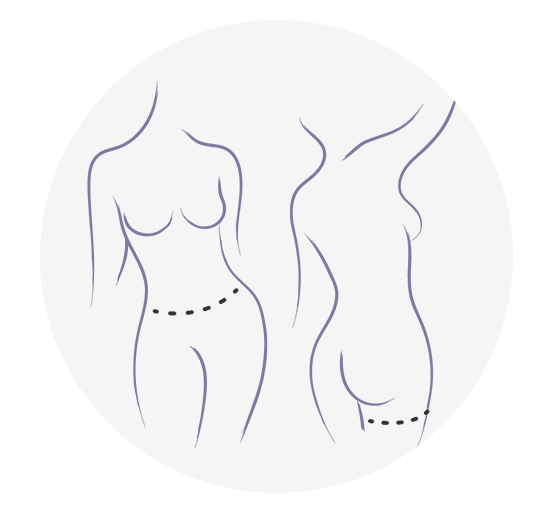This is restricted due to surgical images.
Understanding MRA Imaging in Breast Reconstruction
Presentation by Dr. Joshua L. Levine
Transcription of above presentation:
Understanding MRA Imaging In Breast Reconstruction | Introduction
Today, I’ll be talking to you about MRA Imaging in Breast Reconstruction, or MR angiography. This is a study that we get through radiology on all of our patients who are going to undergo perforator flap breast reconstruction, namely, a DIEP, which is a deep inferior epigastric artery perforator flap. The P in perforator flap is for the perforator or the blood vessel that moves through the muscle or perforates through the muscle in order to supply blood to the overlying skin and fat. So, the MR angiogram is absolutely essential in the planning of perforator flap breast reconstructive surgery.
MRA Imaging In Breast Reconstruction | Advancements Since the Handheld Doppler
What we’re looking at here is a typical MR angiogram, which we will be evaluating for the planning of a perforator flap surgery. Let me just say a few words about MR angiography before I get into explaining some of the anatomy and some of the information that we can learn from the MR angiogram.
Prior to imaging for perforator flap breast reconstruction, we only had the handheld Doppler, which allowed us to listen for a signal, and we could hear the blood vessels that we wanted to use potentially to transfer the tissue but we didn’t see them until we got into the operating room, and sometimes the sound or the signal that we hear from a blood vessel does not correlate directly with the quality of the blood vessel. So, with the advent of imaging, we really began to enter an era in which we could plan the surgeries much, much more carefully, and it really enhanced our ability to offer the procedure and to be successful in the procedure and in new ways.
MRA Imaging In Breast Reconstruction | The First Imaging for Perforator Flaps
The first imaging for perforator flap breast reconstruction was done by a group in Barcelona and they used CT angiography or CT angiogram, and this was very, very revolutionary and very effective and is still used in many centers today. But, the problem with CT is that it does radiate patients who are at risk for or who have recently had cancer, so there’s a reluctance to want to expose such patients, or anyone for that matter, to radiation if it’s not necessary. Additionally, we the newer protocols reducing the amount of radiation given for just that same reason, the quality of the images with CT angiography is not really that great. So, we developed the MR angiography protocol back in 2006, and we’ve been using it and honing it and developing it ever since. There are many publications that we have written on MR angiography.
Understanding the MRA | Patient Example – Abdomen
So, this is a typical MR angiogram, and what we’re looking at here is a cross section of the patient’s abdomen. And so, as I go up and down you’re seeing various levels of the patient’s abdomen, and right there in the middle of the screen is the patient’s belly button or umbilicus. So, that’s a nice reference point so that if I go in one direction I’m going above the belly button and if I’m going in the other direction I’m going below the belly button, and that’s very important to know.
Just to give you some orientation back on this belly button image, the most superficial or the uppermost part of the anatomy that you see here is the patient’s skin, right below that you see fat, and then right below that you see the rectus abdominis muscles, and right below that you see the intraabdominal contents, this being the bowels and this being the aorta here. This is the vena cava. Anything that has a white or lighter color has the contrast in it, which is exactly what we want. The contrast is opaque to the MR angiography machine so that it lights up very nicely, and we can see anything that lights up is a blood vessel because the contrast has been administered through the patient’s vein.
MRA Imaging In Breast Reconstruction | Interpreting the Image
So, when we shoot the image, we are doing it in such a way that we are timing it for its maximum intensity with the filling of the blood vessels. So, anything you see that’s white is almost definitely a blood vessel. So, again, find the patient’s belly button, and we can scan down now. We’re going to go down, and right now you can already see, in addition to the aorta and vena cava, you can already see here’s a nice blood vessel right here and another one right here. this is very typical. These are veins and they’re superficial within the fat. But, as we go down, we can see some blood vessels that are coming – they seem to be either going in or coming out of the abdominal wall. Well, anatomically speaking, they’re actually coming out of because the blood is flowing out into the blood vessel and into the overlying skin and fat, but as we scan down it looks like they’re going in.
As we go down, we can see a very, very large one here, and coming back up on the patient’s right side—this is the patient’s right side—coming back up we see another here. So, either one of these blood vessels would be very, very nice for a DIEP or deep inferior epigastric artery perforator flap because it’s a large vessel and has a very, very short course through the muscle so we can follow it. We follow it from this point as it emerges from the muscle into the fat as it emerges from the muscle into the fat, we follow it down as it goes into the muscle, and we follow it down as it goes to the undersurface of the muscle. At this point, it’s called the deep inferior epigastric, and you can see three, they look like circles. Each one of these represents a blood vessel and this is very typical. The deep inferior epigastric actually refers to both artery and its accompanying veins. Those veins are called venae comitantes. So, we have one artery and two vena comitans, and this is very typical throughout the body, usually in arteries accompanied by veins that sort of run alongside of it on either side of it.
So, coming down, down, down into the patient’s pelvis now, and we can start to see the blood vessels here, the venae comitantes and the deep inferior epigastric artery getting larger as it comes to its origin. Of course, we’re going backwards. The origin is here, which is the external iliac, and as it comes off of the external iliac it is the largest that it will ever be because then it starts to give off branches.
We’re going to follow it up now back where we just were, and here it’s the deep inferior epigastric and its two vena comitans, the two deep inferior epigastric veins, and it is in a location underneath the rectus muscle, which we call the posterior rectus sheath. It’s underneath the rectus and it’s encased in a fibrous membrane called a rectus sheath. So, it’s within the sheath, and as we follow it up you can see it gives off various branches. We call those branches perforators, and here is the one that we ultimately did in fact select and use in this patient. You have your choice and there are a lot of different reasons to choose one blood vessel over another, which will be the topic of another discussion, but this is an excellent example of a very, very nice deep inferior epigastric artery perforator pedicle that was in fact used to carry this flap and make a new breast.
Of course, this is the midline here, and you can remember that we started out at the belly button. This is the fascia in between the two rectus muscles. So, there’s actually also a deep inferior epigastric on this side, which we can easily find, but it’s not as big as the one on the other side as you can see, and so the perforators are a little bit smaller. This side was also used as a deep inferior epigastric perforator flap for breast reconstruction, but since the right-hand side is so much better in terms of its quality I’ll just focus on teaching about that side for today.
Thank you very much. I hope this was helpful to you.





